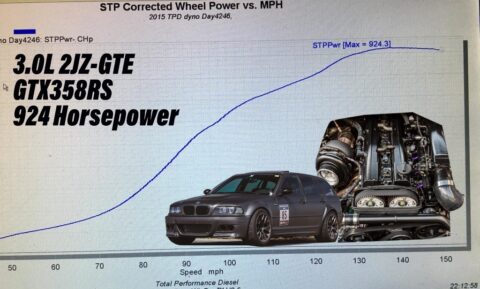Learn More About The Best Turbo Combinations For Your 1JZ / 2JZ Engine
1JZ / 2JZ Engine Performance Data
The Toyota JZ engine family is a series of inline-6 cylinder engines. JZ engines are 24-valve DOHC (dual overhead cam engines) offered in 2.5- and 3.0-litre versions as they progressed through the generations. The 1ZJ was produced from 1990 – 2007 and has a 2.5L displacement and had several configurations GE, GTE, FSE. The 2JZ started production in 1991 and has a 3.0L displacement. This engine displacement range provides many turbocharger options but what’s most important to finding the best turbo for a 1JZ and 2JZ engine is the type of driving and target crank horsepower target. Once all target inputs are identified, the options will narrow. This page will give you tips and dyno performance data from some of the top racers and influencers using the 1JZ and 2JZ engine as a power plant. The data below will help you identify the best turbo for a 1JZ or 2JZ engine. Please note, the performance data below has been provided by race teams that are using Garrett turbochargers and is intended to be used as reference data when identifying a turbo match for a Toyota 1JZ or 2JZ engine. Performance results will vary unless all conditions are identical.
Many racers use the JZ engine because it is a strong and reliable engine that can support over 500 horsepower with little to no modifications. These engines are easy to find, affordable, and easy to work on which makes it a great starter engine for some. For others, when paired with aftermarket performance parts, it can support over one-thousand horsepower and is commonly used for drifting, drag racing, land speed, time attack and more.
Adam LZ: 520 Horsepower JZX100 Toyota Chaser
With multiple dyno sessions at Titan Motorsports, the 1JZ with a Garrett G25-660 maxes out at 520 horsepower and 493 lb-ft of torque at 6000 RPM on 34 PSI of boost pressure. The dyno comparison in the image shows the same car before and after with improvements to the fuel pump. Max torque comes in at 4000 RPM and Max horsepower around 5500 RPM with power dropping off around 6000 RPM due to reaching the flow limit of the turbine. Adam LZ does mention that the car will eventually be back on the dyno one the fuel pump issues are fixed so until then enjoy the videos below and if you are looking for more information on the G25-660 turbo click here to visit the product page.
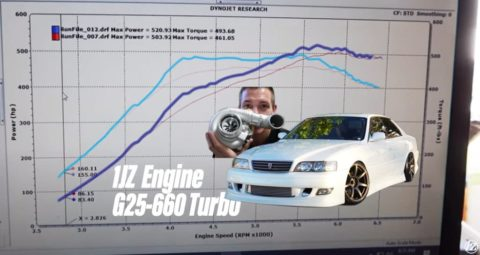
Ryan Tuerck’s 2019 Drift Car uses a 3.0L 2JZ engine boosted by a Garrett G42-1200C, a combination that made just over 1000 horsepower to the wheels. The C stands for compact. The G Series G42-1200 is offered with two compressor housing options, one with a compact design for smaller engine bays and the standard G42-1200 full frame compressor housing.
Ryan’s Toyota 86 is a compact car with a small engine bay especially after his team crammed a 3.0L 2JZ engine into it. The G42-1200C has a 73mm compressor wheel, and supports engine displacements from 2.0L – 7.0L making a 2JZ engine a great selection for this turbo. The 3.0L 2JZ with VVTi is built with a Brian Crower crank, rods, and cams for the bottom end assembled by Accelerated Performance. Supertech Performance provided 9:1 comp pistons, springs, retainers, valves to round out a strong top end with OCD Works porting and assembling head.
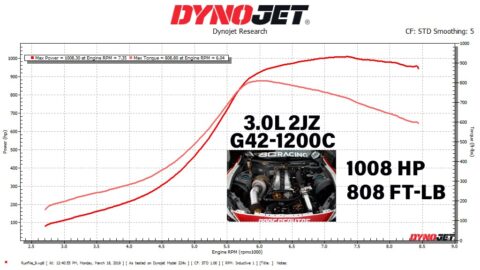
Adam LZ Makes 605 HP On A 1.5JZ Swapped E36 BMW
We caught a glimpse of Adam LZ’s BMW E36 drift car and did a double take when we saw the engine bay because it has a Toyota 1.5JZ motor swap making 583 horsepower and 619 lb-ft of torque at 7000 RPM with a single 54mm G30-660 turbo! Follow along as we dive into how he and the crew did it.
In short, it’s when you mate the top end of the 1JZ engine with the bottom end of the 2JZ platform. You gain 0.5L of displacement making this a 3.0L engine combo which will allow the G30-660 turbo to spool quicker and give the driver a larger powerband. With some modifications to the oil passages and engine block, a new coolant neck, it’s relatively straight forward. The 2JZ engine block is a little taller than the 1JZ so the piping to the intercooler must also be modified. In this scenario, the original 1JZ was working for a little while until the crank bearing wore out and forced Adam to pull the motor to inspect.
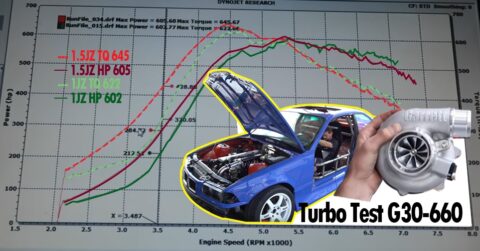
E85 or Pump Gas Power With Cody Miles 1JZ Drift Car
Cody opted for the 2.5L 1JZ VVTI option for more useable power throughout the rpm range. After experiencing the performance of an SR20 he knew he had to have something that would spool incredibly quick, while also being capable of laying down 600whp. With those requirements, while also not wanting to run large amounts of boost (for the sake of heat management), I landed on the G30-770. The G30-770 to deliver ALL of the power needed for a smoke show, while somehow remaining magically responsive with minimal lag! The technology being meticulously thrown into the design of these turbines, compressors, and bearings known as the G series, is simply unmatched. The new turbo will be connected to the engine with a Future Fabrication v-band exhaust manifold.
The dyno results are stunning and here you can see two tunes because Cody can use either 91 octane or e85. The dotted line is 91 and the solid lines are e85. e85 Tune: 613 horsepower / 524 Ft-Lb at 25 PSI 91 Pump Gas: 445 horsepower / 388 Ft-Lb at 18 PSI
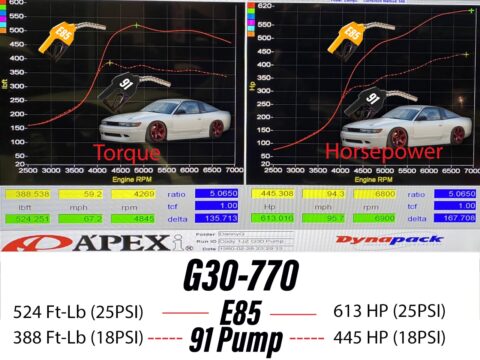
Dai Yoshihara’s 3.4L 2JZ Powered Pikes Peak Toyota 86
Daijiro Yoshihara utilizes a Garrett G42-1200 turbocharger for the 2020 Pikes Peak Hill Climb Race. The Evasive Motorsports Toyota 86 race car is powered by a 3.4L 2JZ engine so it has stroker kit to give it 0.4L more engine displacement. The G42-1200C turbocharger will provide better efficiency and power at elevation than the GTX3852R Gen II that was used in 2019. The 3.4L 2JZ engine pairs well with the larger G42 turbocharger to reduce back pressure and heat build up without losing response. While the dyno was not conclusive to actual power, the Evasive Motorsport team estimates the car would have made 700 horsepower at 20 PSI.
This combination allowed Dai Yoshihara and the Evasive Motorsports Team to claim the fastest time for the Unlimited Class with a 10:05.006 time.
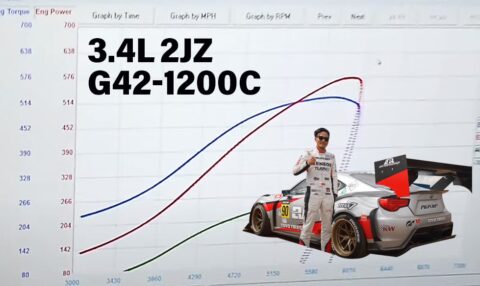
3.0L 2JZ GTX3582R Gen II Makes 630 Horsepower At 7000RPM On 30 Lbs Of Boost!
The 370Z is running a 3.0L 2JZGTE VVTI power plant boosted by a Garrett GTX3582R Gen II turbocharger and a T4 1.06A/R turbine housing. The engine remains mostly stock with only a few upgrades to the valve springs, ARP head studs, and copper head gasket. George says, “The 2JZ is one of the best engines for drifting and for high horsepower applications. The head flows so well when left stock and it already has a turbo on it from the factory so upgrading the turbo and making big power is easy.” The GTX3582R Gen II is a great choice for the 2JZGTE engine because the 6868 mm turbo wheel compressor to turbine wheel combination provides big power and quick boost response. The power curve provides sufficient boost at a wide range of RPMs needed for drift events.
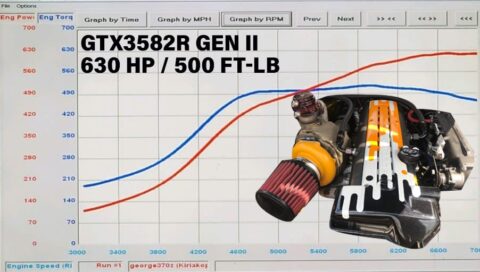
Dylan Hughes Tests The G35-1050 and the G42-1200C On His 3.0L 2JZ Engine
Our favorite part of his car is the engine and turbo combinations. A stout 3.0L 2JZ motor that makes 860 horsepower to the wheels with a G35-1050 turbo for small tracks and 946 horsepower with a G42-1200 for the larger tracks that need a little more power. A comparison of the two turbochargers shows the G35-1050 reaches max torque about 500 RPM sooner than the G42, but the G42 because of its larger compressor wheel can make about 100 more horsepower. First, we tried the G35-1050 1.21 A/R exhaust housing and at 8000 RPM it made 860 wheel horsepower on 31 psi of boost with exhaust back pressure of 48 lbs. The second turbo we tested is the G42-1200 1.01 A/R exhaust housing and at 8600 RPM it made 946 wheel horsepower on 31 psi of boost with exhaust back pressure of 32 lbs” “The G35-1050 made almost 200 ft-lb more torque at 4500 rpm, which is where we need it most. We will run the G35-1050 for most of the FD season because it makes good power with better spool.
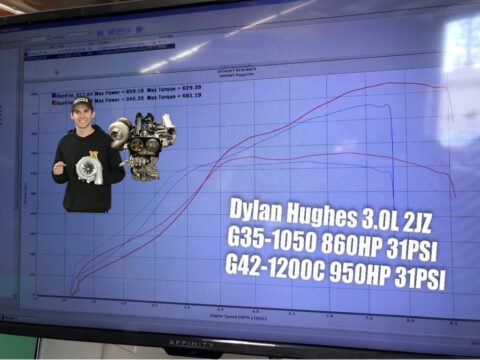
Battle Wagon Makes 900 Horsepower With It’s 3.0L 2JZ-GTE Engine And GTX3584RS Turbo
Skilled craftsmen, Lawrence Shipman, Jason Ford, and Scott Birdsall of Chuckles Garage in Santa Rosa, California were the men to make this vision a reality. The first step was to pluck the factory BMW M52 inline 6-cylinder engine from its home to make way for a more capable 6-cylinder solution. With forced induction a must and big horsepower a given, the team agreed that Toyota’s legendary turbocharged 3.0-liter 2JZ-GTE engine was the right choice for the job. Sporting a cast iron block and 86mm bore and stroke, the 2JZ-GTE offered much greater performance potential than the factory engine.
. The Garrett GTX3584RS turbocharger delivers airflow to produce 550-to-1,000 horsepower in 2.0L – 5.5L engine applications thanks in part to the 6768 turbo compressor to turbine wheel combination. This is the highest output turbocharger in the mid-framed class and an ideally sized turbocharger to reach this project’s horsepower target. Driving GTX3584RS turbocharger to generate boost requires a DOCrace equal-length exhaust manifold feeding spent gasses from the exhaust ports into the turbine inlet of the stainless steel 1.01 A/R v-band turbine housing. The 67mm inducer draws in ambient air to be compressed within the aluminum compressor housing. From the compressor outlet, the charge air flows through the intercooler. The cooler, denser charge air rushes toward the throttle body and intake manifold. With boost pressure set at 28psi an AEM Infinity engine management system dictates the fuel and ignition tables for E85 fuel. Once calibrated, this BMW wagon produced 924 horsepower to the rollers of a Dynojet dynamometer.
